Key takeaways:
- Album playlists are crafted to evoke emotions and tell a story, enhancing the listener’s connection to the artist.
- Metal albums encapsulate the genre’s identity, featuring powerful narratives and reflecting a band’s evolution through their musical journey.
- Playlist curation involves clear themes, emotional resonance, and attention to the flow between tracks to create a compelling listening experience.
- Tools like digital platforms, tagging apps, and dedicated playlist-builders aid in organizing music and enhancing personal connections with songs.
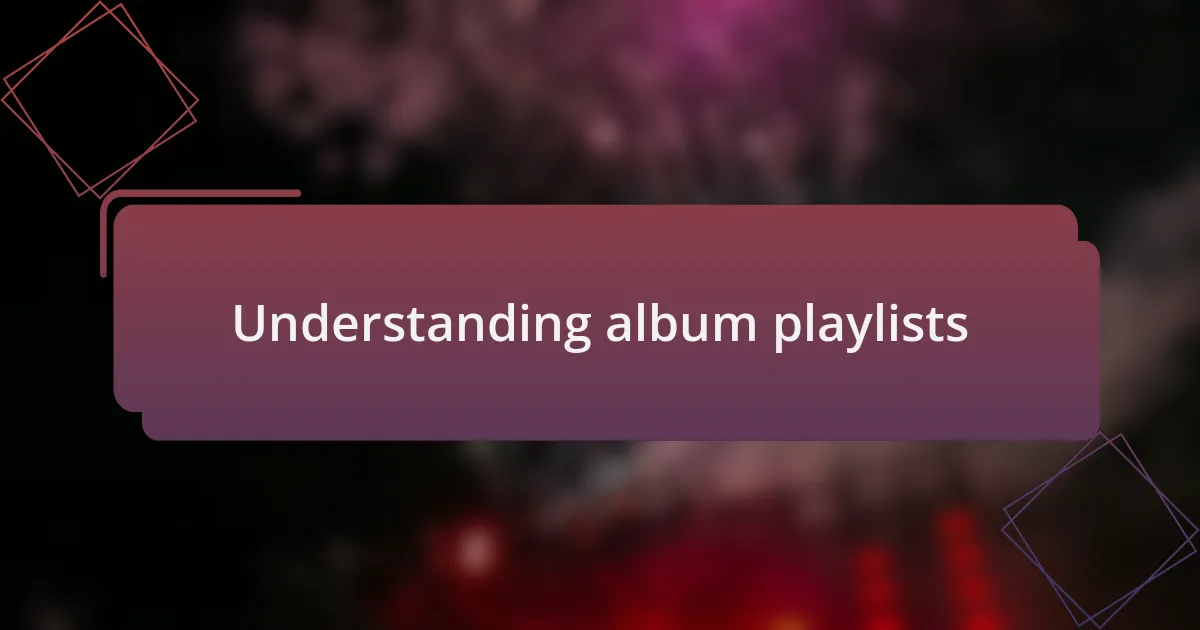
Understanding album playlists
Album playlists serve as a curated journey through an artist’s vision, combining tracks that resonate with a particular theme or emotion. I remember the first time I listened to a full album from start to finish, captivated by how the songs flowed into one another, creating a cohesive experience. Isn’t there something special about an album that pulls you in and makes you feel deeply connected to the artist’s story?
When I curate my album playlists, I often think about the mood I want to convey, whether it’s the catharsis of an emotional ballad or the adrenaline rush of an epic metal anthem. There are moments when a particular track hits me hard, reminding me of a pivotal time in my life. Does each song evoke a memory or feeling for you as well?
Understanding the architecture of an album playlist isn’t just about sequencing tracks; it’s about the emotional impact each one delivers. For instance, I find that strategically placing a powerful ballad amidst a series of heavier tracks can heighten the emotional weight of the overall experience. It’s that ebb and flow of intensity that makes for a compelling listen. Don’t you think such dynamics can transform a simple playlist into a profound soundtrack for our lives?
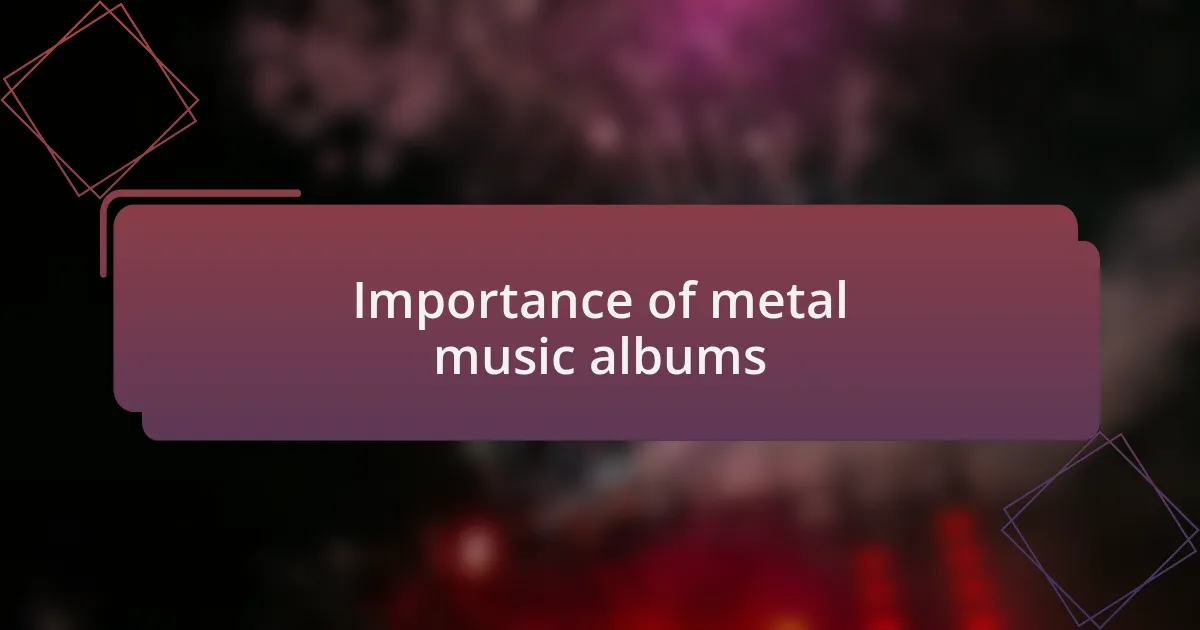
Importance of metal music albums
Metal music albums are crucial in defining the identity of the genre, as they encapsulate the raw emotions and themes that resonate deeply with fans. I recall the first time I listened to an iconic album like Metallica’s “Master of Puppets,” and how it felt like I was plunged into a world of intensity and complexity. Isn’t it amazing how a single album can forge a connection that lasts a lifetime?
Beyond just being a collection of songs, metal albums carry powerful narratives—often delving into societal issues, personal struggles, or fantasy realms. When I immersed myself in Iron Maiden’s “The Number of the Beast,” I was struck by how each track told a story, inviting me to explore deeper meanings. Have you ever found yourself reflecting on the themes presented in an album long after the last note has faded?
Moreover, the artistry of album construction often highlights the evolution of a band. Experiencing the transition from Slayer’s aggressive sound in “Reign in Blood” to the more melodic elements in their later work was eye-opening. It made me appreciate how albums play a pivotal role in showcasing a band’s growth and musical journey. Wouldn’t you agree that this journey adds an extra layer of appreciation for both the artists and their devoted listeners?
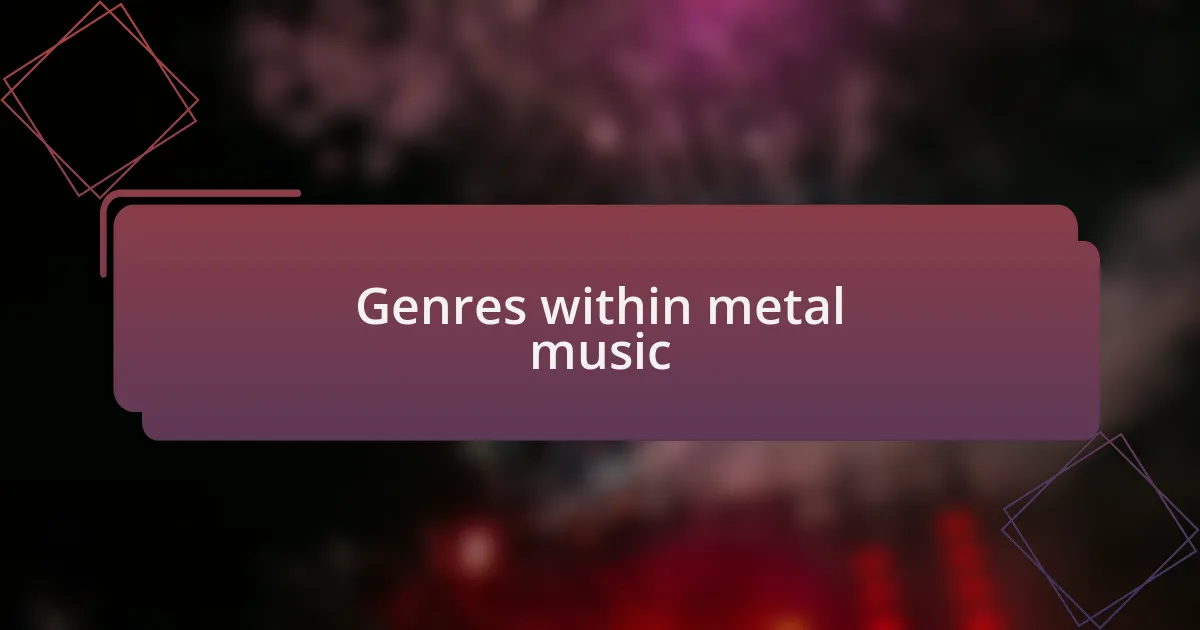
Genres within metal music
When you dive into metal music, you’ll quickly discover an impressive range of subgenres, each with its own unique vibe and characteristics. For instance, I remember stumbling upon doom metal for the first time—its slow, heavy riffs felt like a sonic embrace laced with melancholic beauty. Have you ever experienced a sound that completely shifted your understanding of what metal can be?
Death metal, on the other hand, unleashes a ferocity that’s hard to ignore. The guttural vocals and blistering guitar work always fuel my adrenaline. I can’t forget the first time I heard Cannibal Corpse; the raw intensity left me both exhilarated and slightly in awe. It makes me wonder: how can such aggressive music evoke both power and reflection in its listeners?
Moreover, subgenres like power metal shift the tone entirely, opting for soaring vocals and epic themes that can feel almost cinematic. When I first heard Blind Guardian’s “Imaginations from the Other Side,” I was transported into a fantastical narrative that made me want to embark on my own adventurous journey. Doesn’t it thrill you to see how diverse metal can be, providing something for every listener while still retaining that unmistakable heartbeat of rebellion?
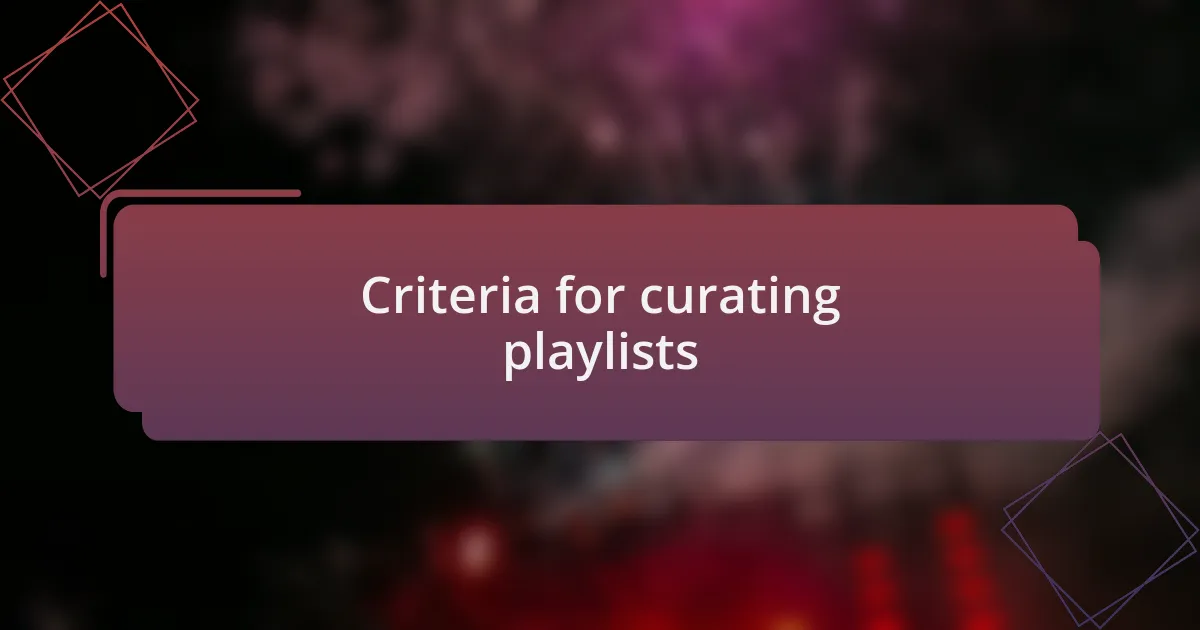
Criteria for curating playlists
When I curate my playlists, I start with a clear theme in mind. For instance, I once crafted a playlist around the concept of “transformation,” pairing tracks that showcase musical evolution within the metal genre. Tracks that take you on a journey—from the intensity of Black Metal to the melodic intricacies of Progressive Metal—provide a layered listening experience that keeps me engaged. Have you ever noticed how a cohesive theme can suddenly make an album feel like a story worth telling?
Next, I prioritize emotional resonance. The first time I heard “Fade to Black” by Metallica, the sheer vulnerability intertwined with powerful riffs struck a deep chord. I aim to include songs that evoke strong feelings, whether it’s nostalgia, rage, or empowerment. This emotional connection not only enriches the listening experience but also makes the playlist feel personal and relatable. How does music affect your mood in unexpected ways?
Lastly, I consider the flow and transition between tracks. A well-placed shift from a high-energy song to something more introspective can create a dramatic impact. I remember placing an intense Sepultura track right before a serene, atmospheric piece by Opeth in one of my playlists; the contrast was electric. How do you find the balance between different energies to maintain rhythm in your own playlists?
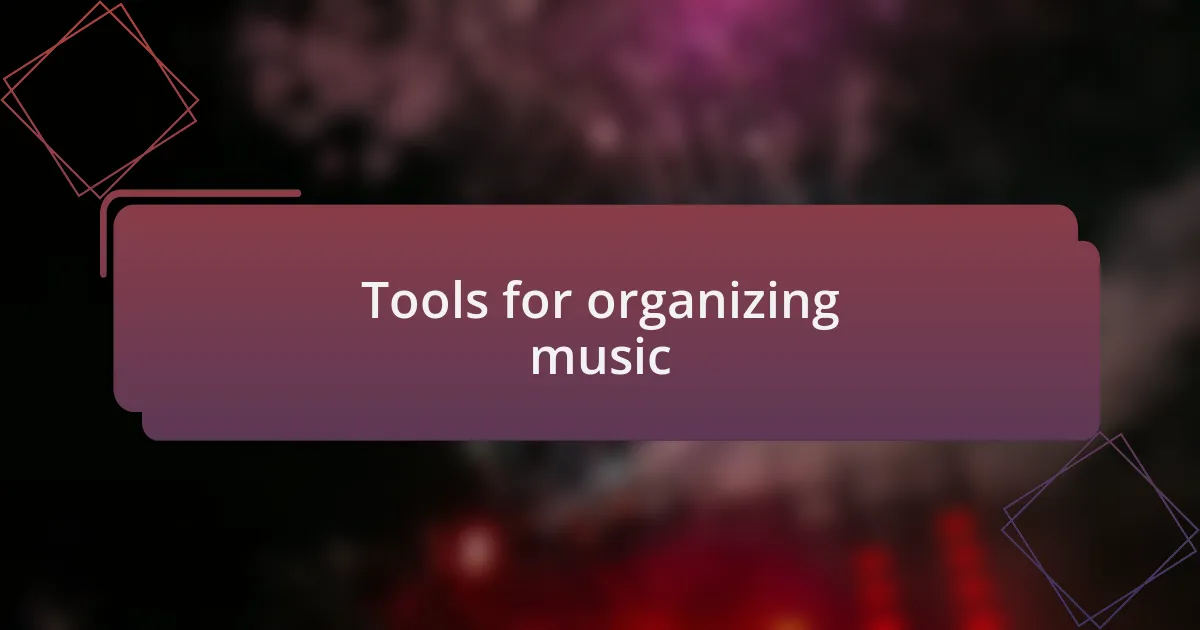
Tools for organizing music
There are several tools I rely on to keep my music organized. I swear by digital platforms like Spotify and Apple Music because they offer intuitive features for playlist curation. With a simple drag-and-drop interface, I can mix tracks based on their mood or energy, allowing me to experiment with flow seamlessly. Have you ever tried reorganizing your playlist while listening to it? It’s like rearranging the pieces of a puzzle until everything clicks into place.
Additionally, I find tagging and note-taking tools are invaluable. They allow me to jot down thoughts or themes associated with specific tracks. For example, using a notes app, I once sketched out my evolving feelings about specific metal tracks as I was curating a playlist for a friend’s birthday. Reflecting on that process, it struck me how the act of writing down my feelings deepened my connection to the music. Do you ever find that documenting your thoughts enhances your appreciation of songs?
Another option is utilizing dedicated playlist-building apps like SongShift or Soundiiz. These tools allow you to transfer playlists between different platforms, saving time and keeping my musical catalog neat and consistent. I remember feeling a sense of relief the first time I used SongShift to unify my favorite tracks across various services, which made searching for my go-to songs so much easier. Have you experienced that moment when everything just clicks into alignment?
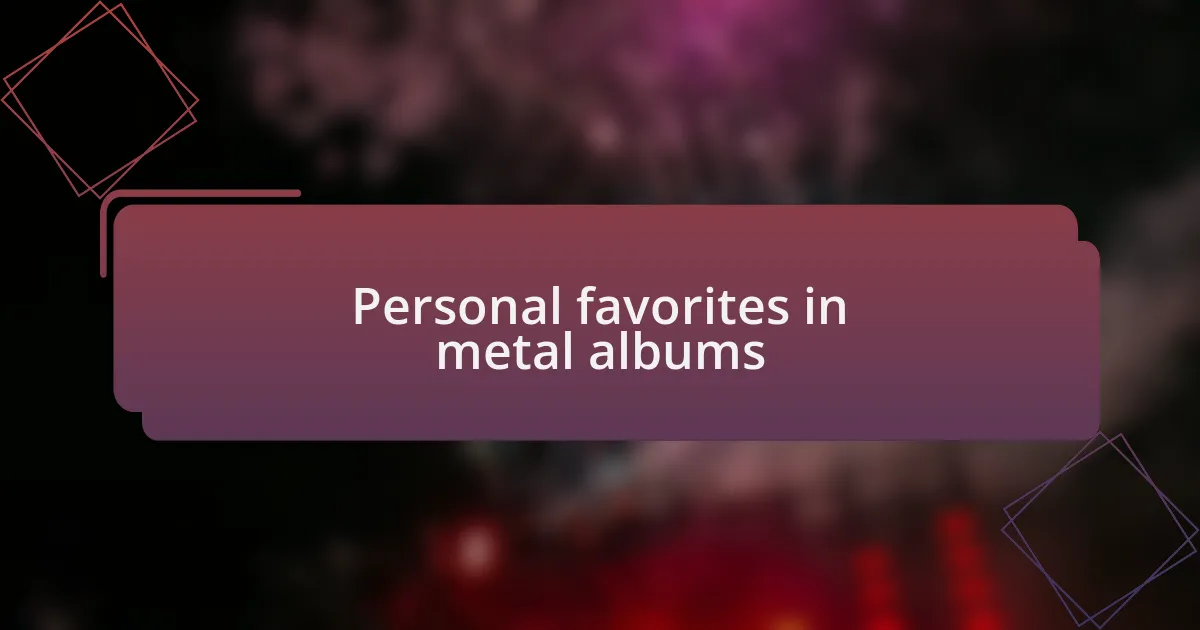
Personal favorites in metal albums
When it comes to personal favorites in metal albums, my choices often reflect both nostalgia and raw energy. One standout for me is “Master of Puppets” by Metallica; the intricate guitar work and compelling lyrics have always resonated deeply with my own struggles and triumphs. Have you ever lost yourself in a track that felt like it was speaking directly to you? For me, that album was a soundtrack during some formative years.
Another favorite that never escapes my playlist is “Reign in Blood” by Slayer. The ferocity of those tracks brings a rush of adrenaline that’s hard to replicate. I vividly recall driving down an empty highway with this album blasting; the combination of speed and aggression made every moment feel electric. Isn’t it amazing how certain albums can evoke specific memories or feelings?
Then there’s “Blackwater Park” by Opeth, which showcases a different side of metal. The seamless blending of heavy riffs with beautiful melodies gives me chills every time I listen. I remember sitting in my room, headphones on, and feeling completely engulfed by the atmosphere created in that album. Do you have those moments where music transcends mere sound and becomes an experience? For me, this album epitomizes that transformative power of metal.
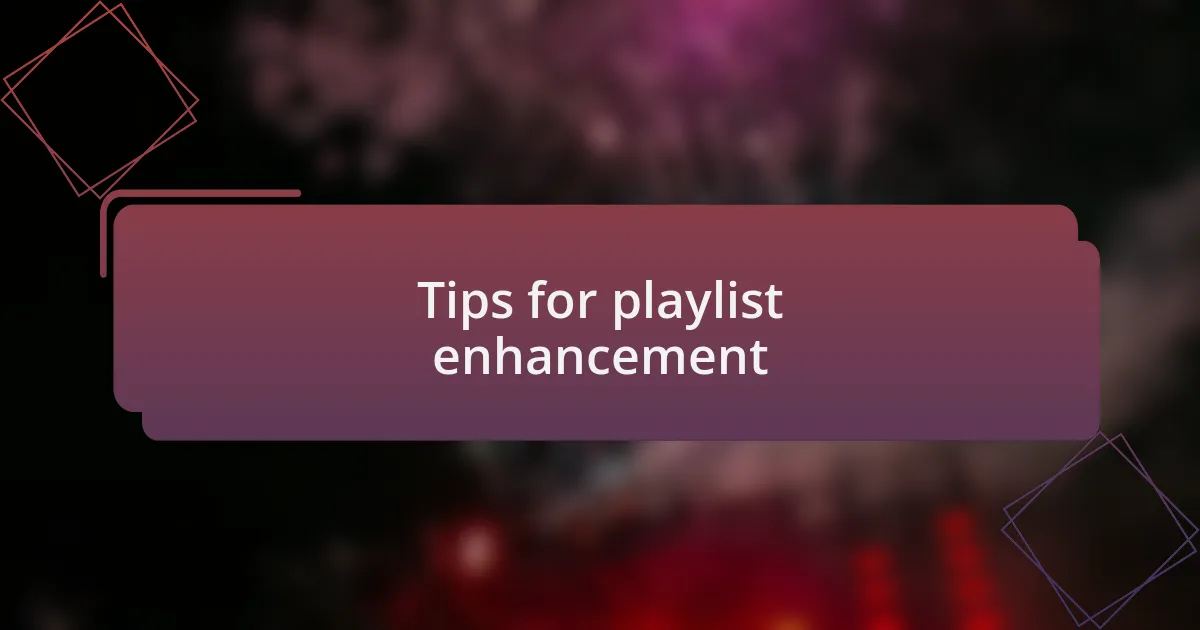
Tips for playlist enhancement
One way I enhance my metal playlists is by creating a flow that truly captivates the listener. I often start with high-energy tracks to set the tone, gradually transitioning into heavier, more complex pieces. It’s like taking the audience on an emotional journey; do you ever notice how the pacing can change the entire vibe of your listening experience?
Another tip I swear by is the importance of variety within the genre. Mixing classic anthems with newer underground bands can breathe fresh life into a playlist. I recall introducing an old friend to some of today’s lesser-known metal acts, and watching their eyes widen in surprise was priceless. Have you ever felt that thrill of discovery when a new track resonates with you unexpectedly?
Lastly, don’t underestimate the power of personal connections to the music. I often incorporate songs that remind me of specific moments or people in my life. Recently, I added a track that played during a memorable road trip with friends—we still reminisce about those days whenever it comes on. How does nostalgia shape your own playlist choices? It’s fascinating to see how our experiences can color our musical preferences.